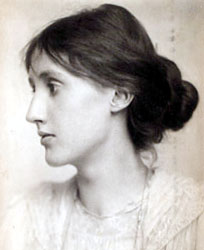
"It blazed a soft yellow, a lambent light under a film of velvet; it filled the caverns behind the eyes with light. All that inner darkness became a hall, leaf smelling, earth smelling, of yellow light."
"A spring of feeling bubbled up through her mud."
"At that she smiled a ravishing girl's smile, as if the wind had warmed the wintry blue in her eyes to amber." (Between the Acts)
Virginia Woolf Book Summaries
Mrs. Dalloway - As Clarissa Dalloway walks through London on a fine June morning, a sky-writing plane captures her attention. Crowds stare upwards to decipher the message while the plane turns and loops, leaving off one letter, picking up another. Like the airplane's swooping path, Virginia Woolf's Mrs. Dalloway follows Clarissa and those whose lives brush hers--from Peter Walsh, whom she spurned years ago, to her daughter Elizabeth, the girl's angry teacher, Doris Kilman, and war-shocked Septimus Warren Smith, who is sinking into madness. As Mrs. Dalloway prepares for the party she is giving that evening, a series of events intrudes on her composure. Her husband is invited, without her, to lunch with Lady Bruton (who, Clarissa notes anxiously, gives the most amusing luncheons). Meanwhile, Peter Walsh appears, recently from India, to criticize and confide in her. His sudden arrival evokes memories of a distant past, the choices she made then, and her wistful friendship with Sally Seton. Woolf then explores the relationships between women and men, and between women, as Clarissa muses, "It was something central which permeated; something warm which broke up surfaces and rippled the cold contact of man and woman, or of women together.... Her relation in the old days with Sally Seton. Had not that, after all, been love?" While Clarissa is transported to past afternoons with Sally, and as she sits mending her green dress, Warren Smith catapults desperately into his delusions. Although his troubles form a tangent to Clarissa's web, they undeniably touch it, and the strands connecting all these characters draw tighter as evening deepens. As she immerses us in each inner life, Virginia Woolf offers exquisite, painful images of the past bleeding into the present, of desire overwhelmed by society's demands.
A Room of One's Own - Surprisingly, this long essay about society and art and sexism is one of Woolf's most accessible works. Woolf, a major modernist writer and critic, takes us on an erudite yet conversational--and completely entertaining--walk around the history of women in writing, smoothly comparing the architecture of sentences by the likes of William Shakespeare and Jane Austen, all the while lampooning the chauvinistic state of university education in the England of her day. When she concluded that to achieve their full greatness as writers women will need a solid income and a privacy, Woolf pretty much invented modern feminist criticism. This literary landmark about the male supremacy and female subordination at Oxford University shines a brave, searing light on the obstacles that must be overcome on the path toward a harmonious unity of the sexes. --This text refers to an out of print or unavailable edition of this title. Essay by Virginia Woolf, published in 1929. The work was based on two lectures given by the author in 1928 at Newnham College and Girton College, Cambridge. Woolf addressed the status of women, and women artists in particular, in this famous essay which asserts that a woman must have money and a room of her own if she is to write. Woolf celebrates the work of women writers, including Jane Austen, George Eliot, and the Brontes. In the final section Woolf suggests that great minds are androgynous. She argues that intellectual freedom requires financial freedom, and she entreats her audience to write not only fiction but poetry, criticism, and scholarly works as well. The essay, written in lively, graceful prose, displays the same impressive descriptive powers evident in Woolf's novels and reflects her compelling conversational style. Originally published in 1929, A Room of One's Own eloquently states Woolf's conviction that in order to create works of genius, women must be freed from financial obligations and social restrictions.
To the Lighthouse - Novel by Virginia Woolf, published in 1927. The work is one of her most successful and accessible experiments in the stream-of-consciousness style. The three sections of the book take place between 1910 and 1920 and revolve around various members of the Ramsay family during visits to their summer residence on the Isle of Skye in Scotland. A central motif of the novel is the conflict between the feminine and masculine principles at work in the universe. With her emotional, poetical frame of mind, Mrs. Ramsay represents the female principle, while Mr. Ramsay, a self-centered philosopher, expresses the male principle in his rational point of view. Both are flawed by their limited perspectives. A painter and friend of the family, Lily Briscoe, is Woolf's vision of the androgynous artist who personifies the ideal blending of male and female qualities. Her successful completion of a painting that she has been working on since the beginning of the novel is symbolic of this unification.